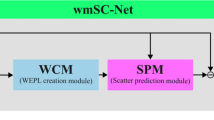Abstract
When using automatic exposure control (AEC) systems in computed tomography (CT), miscalculation of tube current occurs when a patient is not aligned with the rotational center of the X-ray tube. A positioning compensation mechanism provides a corrective function when the patient is off-center; however, not all CT systems are equipped with this mechanism. AEC systems can broadly be divided into noise- and empirical-based. The authors studied empirical-based AEC systems to derive a compensation process to achieve an equivalent effect to that offered by the mechanism and to verify the accuracy of this process. A relational equation was derived to keep the tube current constant with variations in table height and quality reference milliampere-seconds (QRmAs), and this was adopted as the proposed compensation method. The radiation dose and image quality were evaluated for phantom imaging with and without the proposed compensation method using AEC and varying table heights. The output radiation dose and image quality were also evaluated for anthropomorphic chest phantom imaging to verify the compensatory effect of the proposed method. With the proposed compensation method, changes in the table height resulted in only small changes in the output radiation dose and noise level. Conversely, when the proposed compensation method was not used, changes in the table height resulted in widely varying output radiation dose and noise level. Imaging the anthropomorphic chest phantom with the proposed compensation method also yielded a stable output radiation dose.









Similar content being viewed by others
References
Kalra MK, Maher MM, Toth TL, Schmidt B, Westerman BL, Morgan HT, Saini S (2004) Techniques and applications of automatic tube current modulation for CT. Radiology 233(3):649–657
Mulkens TH, Bellinck P, Baeyaert M, Ghysen D, Van Dijck X, Mussen E, Venstermans C, Termote JL (2005) Use of an automatic exposure control mechanism for dose optimization in multi-detector row CT examinations: clinical evaluation. Radiology 237(1):213–223
Kawashima H, Ichikawa K, Hanaoka S, Matsubara K, Takata T (2018) Relationship between size – specific dose estimates and image quality in computed tomography depending on patient size. J Appl Clin Med Phys 19(4):246–251
Tack D, De Maertelaer V, Gevenois PA (2003) Dose reduction in multidetector CT using attenuation based online tube current modulation. AJR Am J Roentgenol 181(2):331–334
McMillan K, Bostani M, Cagnon CH, Yu L, Leng S, McCollough CH, McNitt-Gray MF (2017) Estimating patient dose from CT exams that use automatic exposure control: development and validation of methods to accurately estimate tube current values. Med Phys 44(8):4262–4275
Matsubara K, Koshida K, Suzuki M, Tsujii H, Yamamoto T, Matsui O (2008) Comparison between 3-D and z-axis automatic tube current modulation technique in multidetector-row CT. Radiat Prot Dosim 128:106–111
Matsubara K, Koshida K, Ichikawa K, Suzuki M, Takata T, Yamamoto T, Matsui O (2009) Misoperation of CT automatic tube current modulation systems with inappropriate patient centering: phantom studies. AJR Am J Roentgenol 192(4):862–865
Toth T, Ge Z, Daly MP (2007) The influence of patient centering on CT dose and image noise. Med Phys 34(7):3093–3101
Saltybaeva N, Alkadhi H (2017) Vertical off-centering affects organ dose in chest CT: evidence from Monte Carlo simulations in anthropomorphic phantoms. Med Phys 44(11):5697–5704
Kaasalainen T, Palmu K, Reijonen V, Kortesniemi M (2014) Effect of patient centering on patient dose and image noise in chest CT. AJR Am J Roentgenol 203(1):123–130
Li B, Behrman RH, Norbash AM (2012) Comparison of topogram-based body size indices for CT dose consideration and scan protocol optimization. Med Phys 39(6):3456–3465
Terashima M, Mizonobe K, Date H (2019) Determination of appropriate conversion factors for calculating size-specific dose estimates based on X-ray CT scout images after miscentering correction. Radiol Phys Technol 12(3):283–289
Oladunni OA, Lauren FA, Rebecca N, Elizabeth AK, Xiangyang T, Pardeep KM, William CS, Courtney CM (2018) Prevalence and severity of off-centering during diagnostic CT: observations from 57,621 CT scans of the chest, abdomen, and/or pelvis. Curr Probl Diagn Radiol 48(3):229–234
Mannudeep KK, Pragya D, Sarabjeet S, Sanjay S, Jo-Anne OS (2009) In-plane shielding for CT: effect of off-centering automatic exposure control and shield-to-surface distance. Korean J Radiol 10(2):156–163
Sookpeng S, Martin CJ, Gentle DJ, Lopez-Gonzalez MR (2014) Relationships between patient size, dose size, dose and image noise under automatic tube current modulation systems. J Radiol Prot 34(1):103–123
Menke J (2005) Comparison of different body size parameters for individual dose adaption in body CT of adults. Radiology 236(2):565–571
Burton CS, Malkus A, Ranallo F, Szczykutowicz TP (2019) Model-based magnification/minification correction of patient size surrogates extracted from CT localizers. Med Phys 46(1):165–172
Acknowledgements
The authors thank the staff in the Department of Radiology Technology, Nagoya University Hospital for their kind assistance and Enago (https://www.enago.jp/) for the English language review.
Author information
Authors and Affiliations
Corresponding author
Ethics declarations
Conflict of interest
The authors declare no conflicts of interest associated with this manuscript.
Ethical approval
This article does not contain any studies with human participants or animals performed by any of the authors.
Additional information
Publisher’s note
Springer Nature remains neutral with regard to jurisdictional claims in published maps and institutional affiliations.
Rights and permissions
About this article
Cite this article
Furukawa, Y., Matsubara, K. & Miyati, T. Inadequate object positioning and improvement of automatic exposure control system calculations based on an empirical algorithm. Phys Eng Sci Med 44, 37–44 (2021). https://doi.org/10.1007/s13246-020-00949-1
Received:
Accepted:
Published:
Issue Date:
DOI: https://doi.org/10.1007/s13246-020-00949-1




